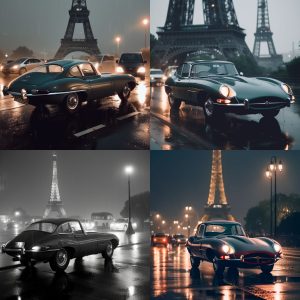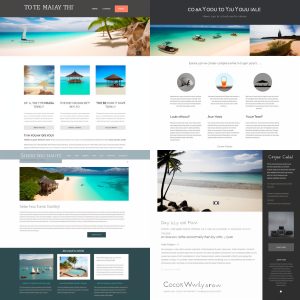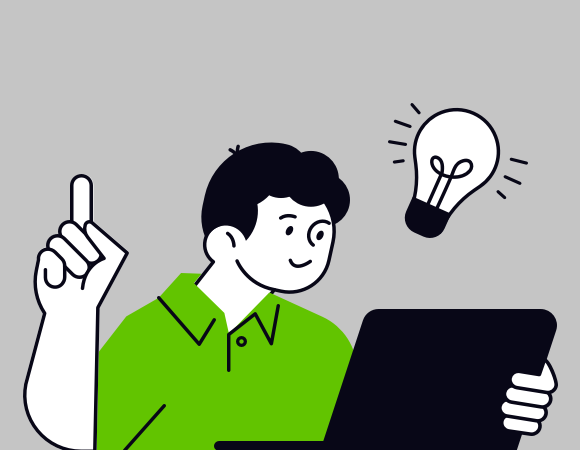AI is a big deal at the moment. And by “the moment”, that likely means from this point onwards in human existence.
We’ve previously talked about AI’s skills as a copywriter and its influence on email marketing in general. Now it’s time to look at another major branch of AI content generation: imagery.
The journey begins
Midjourney is one of the most advanced and best-known AI image generators in the market. If you’re not familiar, let me explain – it’s a form of digital magic that needs to be seen to be believed.
Picture something in your head. Anything. Now type it into Midjourney’s prompt bar. Within seconds, it will generate four images based on your input. How about:
a Jaguar E-Type parked next to the Eiffel Tower in the rain

Incredible, right? Pictured unmistakably are the vehicle, landmark and weather conditions of my choice. But after the initial wow factor has worn off, it doesn’t take much scrutiny to spot the flaws. In one picture the Jag is making a nuisance of itself in the face of oncoming traffic. In another there’s not one Eiffel Tower, but two. This is a landmark that surely doesn’t need any more replicas!
As a user, there are several options at this point. We can spin again and get four brand new images based on our original prompt. Or we can ask Midjourney to create variations of what it’s already generated. Maybe we’d like to do some manual editing in Photoshop, feed the image back to Midjourney and ask it to work from that. Perhaps we’d prefer to rewrite our prompt and be a little more specific.
But let’s move on. We could play with whimsical pictures of this and that all day, but we’re here to examine Midjourney’s potential visual contribution to email marketing.
An a-eye for design
We’re going to test this from two distinct angles:
- Overall email layout
- Individual images
I should preface this by saying that Midjourney clearly isn’t intended for the design of websites or emails. It’s a tool with an artistic bent (and one that gives it a distinct character from its rivals). Nonetheless, let’s see what it can do as a source of design inspiration.
We’ll work with purpose. Our goal is to design an email for a make-believe travel company. Its brand colours are a sunny blue and a beachy tan. Those can sit on a traditional white background, with body copy rendered in an eye-pleasingly contrasting dark grey. AI can’t read our minds (yet), so my request is quite specific:
Marketing email for a travel company. Beach imagery. White background. Dark grey text. Use of colours #6084f7 and #c1aa60
And here’s what it came up with:

TO TE MAIAY THI – do you know what language that is? It’s mangled English. And that’s an indicator as to how AI image generators work. The output is a visual echo, based on countless source images that have been fed in. That’s why it’s not uncommon to see distorted intepretations of brand watermarks or artist signatures. As with all AI products, we’re seeing the results of complex algorithms rather than any real intelligence.
But can we make use of these mock-up emails? Of the four images above, option 1 is the most useful. It may have largely disregarded my colour choices, but in terms of layout and volume of content it’s the most plausible as an email. Now we’ll conjure up some imagery to bring it to life.
It’s a kind of image-ic
The big beach image from our layout mock-up is pretty nice:

That picture is of too low resolution to use in its current form but thankfully Midjourney is a flexible tool. I’m going to feed the image back to the platform, along with some instructions:
[beach.jpg] panoramic illustration of a yacht next to a tropical beach with palm trees and rocks --ar 11:4
That ‘ar’ tag at the end is a way to define the aspect ratio of our images. We don’t want the default square shape in this case, so I’ve picked dimensions that suit a long strip-like image.
Here’s the result:

I like option 4. So let’s upscale it to a useable resolution, and I’ll modify the colours a little in Photoshop to make it more on-brand.

We have a layout. We have a main image. Now we can move onto the final step.
Assembly required
Let’s put the AI-generated components into an actual email. If this was a real commercial mailing, we’d have generated many more trial layouts and images, and made a lot more edits along the way. Working with AI tools feels a bit like the infinite monkey theorem. Spin and spin again until we finally get the result we had in mind.
But what we have here is good enough for experimental purposes. Here’s the final product:
Is it a revolutionary design? No. Could the main image be better? Yes. The point isn’t perfection but progress.
Some final thoughts on AI email design
AI content-creation tools are becoming more sophisticated and widespread. It’s not far-fetched to see image generators becoming an everyday tool that lets marketers conjure up fresh, on-brand graphics in seconds.
In answer to the opening question – can AI design a marketing email – my verdict is sort of. It can certainly help. But at the current rate of progress, who knows what it’ll be capable of a year from now.


